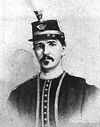 Rush Christopher
Hawkins was born in Pomfret, Vermont, on September 14,
1831. He left home at age 15 to enlist in the
Mexican War and, though underage, was eventually
entered in the Second Dragoons. After the
Mexican War he studied law and settled in New York
City. During the Civil War Hawkins served
as Colonel of the 'Hawkins Zouaves', the 9th New York
Volunteers, and was raised by brevet to the rank of
Brigadier General in 1866. Hawkins continued to
participate in public life publishing works on
history, politics and culture (see selected list
below) and devoting himself to building collections
of early printed books and early and modern works of
art. In his 90th year Hawkins was struck by an
automobile as he crossed Fifth Avenue and died on
October 25, 1920.
Rush Christopher
Hawkins was born in Pomfret, Vermont, on September 14,
1831. He left home at age 15 to enlist in the
Mexican War and, though underage, was eventually
entered in the Second Dragoons. After the
Mexican War he studied law and settled in New York
City. During the Civil War Hawkins served
as Colonel of the 'Hawkins Zouaves', the 9th New York
Volunteers, and was raised by brevet to the rank of
Brigadier General in 1866. Hawkins continued to
participate in public life publishing works on
history, politics and culture (see selected list
below) and devoting himself to building collections
of early printed books and early and modern works of
art. In his 90th year Hawkins was struck by an
automobile as he crossed Fifth Avenue and died on
October 25, 1920.

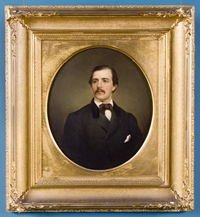 Annmary Brown,
daughter of Nicholas Brown (Class of 1811),
granddaughter of Nicholas Brown (Class of 1786) whose
name the University adopted in 1804, and sister of
Carrie Brown Bajnotti, whose memorial is Carrie
Tower, was born in Providence on March 9, 1837.
She spent her early years in Tappan, New York,
accompanied her parents to Rome when her father was
appointed Consul-General, and was later educated in
Geneva at Madame Arlaud's select school. Annmary Brown and Rush Hawkins were married
in 1860. After her death from pneumonia in 1903
Hawkins decided to build a memorial in her memory.
It was to be "first of all a Memorial to a woman
of noble character [and] secondarily a collection of
art treasures." The Memorial was to
contain Hawkins' book and art collections as well as
his Civil War memorabilia and the General and Mrs.
Hawkins' personal correspondence and mementos of
their life together. General and Mrs. Hawkins
are entombed in a crypt at the rear of the building. General
Hawkins' placed fresh flowers on his wife's tomb each
year on her birthday, a practice which continues to
this day.
Annmary Brown,
daughter of Nicholas Brown (Class of 1811),
granddaughter of Nicholas Brown (Class of 1786) whose
name the University adopted in 1804, and sister of
Carrie Brown Bajnotti, whose memorial is Carrie
Tower, was born in Providence on March 9, 1837.
She spent her early years in Tappan, New York,
accompanied her parents to Rome when her father was
appointed Consul-General, and was later educated in
Geneva at Madame Arlaud's select school. Annmary Brown and Rush Hawkins were married
in 1860. After her death from pneumonia in 1903
Hawkins decided to build a memorial in her memory.
It was to be "first of all a Memorial to a woman
of noble character [and] secondarily a collection of
art treasures." The Memorial was to
contain Hawkins' book and art collections as well as
his Civil War memorabilia and the General and Mrs.
Hawkins' personal correspondence and mementos of
their life together. General and Mrs. Hawkins
are entombed in a crypt at the rear of the building. General
Hawkins' placed fresh flowers on his wife's tomb each
year on her birthday, a practice which continues to
this day.

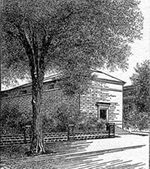 The Annmary Brown
Memorial, constructed between 1903 and 1907 to the
design of Rhode Island architect Norman Isham, was
independent until 1948, when it was deeded to Brown
University. In 1990 Hawkins' book and
manuscript collections were removed to the John Hay
Library with the exception of personal effects and
the General's collection of books by and about people
named Hawkins. The majority of the paintings, many of
which had previously graced the couple's home, remain
in the Memorial's galleries and storage facilities.
The Annmary Brown
Memorial, constructed between 1903 and 1907 to the
design of Rhode Island architect Norman Isham, was
independent until 1948, when it was deeded to Brown
University. In 1990 Hawkins' book and
manuscript collections were removed to the John Hay
Library with the exception of personal effects and
the General's collection of books by and about people
named Hawkins. The majority of the paintings, many of
which had previously graced the couple's home, remain
in the Memorial's galleries and storage facilities.
Shortly
after
founding the Memorial Hawkins engaged C.H. Collins
Baker to produce a catalog
of the Memorial's collection of paintings which
was published in 1913. (Baker later cataloged
several of the Huntington Library and Art Gallery's
collections and his archive of exhibition catalogs
and newspaper clippings on British art is housed
there.)
Paintings, in oil
& water colours by early & modern
painters, collected by Rush C. Hawkins,
catalogued by C.H. Collins Baker and deposited in
the Annmary Brown Memorial at Providence, Rhode
Island, London, Printed for the owner by
the Medici Society, 1913
» Josiah record
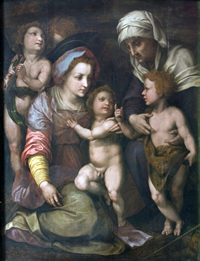 One hundred and
seventeen paintings are included in the second
One hundred and
seventeen paintings are included in the second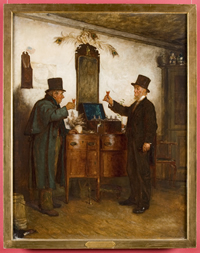 edition of this catalog, fifty-six by
'early painters' and the remainder 'modern painters'.
Hawkins' preference was for representational works
and Baker in his preface explains that "redhot
Impressionism, Post-impressionism and Futurism are
not included in the arc General Hawkins set himself
to traverse as regards the representative nature of
the Annmary Brown Memorial Collection."
Baker also describes the patriotic motive behind
Hawkins' collection building efforts.
edition of this catalog, fifty-six by
'early painters' and the remainder 'modern painters'.
Hawkins' preference was for representational works
and Baker in his preface explains that "redhot
Impressionism, Post-impressionism and Futurism are
not included in the arc General Hawkins set himself
to traverse as regards the representative nature of
the Annmary Brown Memorial Collection."
Baker also describes the patriotic motive behind
Hawkins' collection building efforts.
"America in
contrast with Europe has no aesthetic heritage...A
community deprived of aesthetic canons,
especially a civilised community, would sooner or
later deteriorate into sheer materialism.
Realising this, patriotic Americans have pledged
themselves to make up for America's lack of an
art heritage by importing the finest examples of
European and Eastern art that fall within their
range."
Hawkins
in the introduction to the catalog describes his hope
that the collection will instruct and edify the
American public at large.
"From the
first, one part of the governing purpose was to
bring together a small collection representing
the greater Schools of early painting, and if
possible to procure representative works by some
of the most famous artists of each. So that
when brought together in a single room, student
or layman would be able at a glance to become
acquainted with some of the better work of the
early art periods of several of the older
countries that promoted the cultivation of the
arts."
The
collecting of culturally representative works also
informed Hawkins' book collection method by which he
very successfully attempted to acquire a
representative book (preferably the first) issued by
each of the first printers during the 'incunabula'
period from Gutenberg's discovery in the mid 1450's
to the end of the 15th century. Just as he would
do with his art collection he engaged the best expert
he could find - Alfred W. Pollard, former Keeper of
Printed Books at the British Museum - to produce a
catalog of his collection.
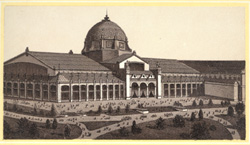 Rush Hawkins was
recognized by his contemporaries both as a
distinguished book collector and a discriminating
patron of the arts. He was appointed Assistant to the
Commissioner General for the United States Commission
at the 1889 Universal Exposition in Paris. As "Commissaire
Expert des Beaux Arts," he was responsible for
selecting and organizing all the works to be
exhibited by American artists, some of whose work he
later purchased for his private collection. He
succeeded in alienating James McNeill Whistler, who
withdrew his work from the American exhibition in
protest when ten of his twenty-seven submissions were
rejected. Their artistic feud was publicly conducted
in the pages of the Paris edition of The New York
Herald and later memorialized in Whistler's extended
essay on The Gentle Art of Making Enemies (Chelsea,
1890, pp. 264-276). Hawkins' official
report is a spirited critique of contemporary art.
Rush Hawkins was
recognized by his contemporaries both as a
distinguished book collector and a discriminating
patron of the arts. He was appointed Assistant to the
Commissioner General for the United States Commission
at the 1889 Universal Exposition in Paris. As "Commissaire
Expert des Beaux Arts," he was responsible for
selecting and organizing all the works to be
exhibited by American artists, some of whose work he
later purchased for his private collection. He
succeeded in alienating James McNeill Whistler, who
withdrew his work from the American exhibition in
protest when ten of his twenty-seven submissions were
rejected. Their artistic feud was publicly conducted
in the pages of the Paris edition of The New York
Herald and later memorialized in Whistler's extended
essay on The Gentle Art of Making Enemies (Chelsea,
1890, pp. 264-276). Hawkins' official
report is a spirited critique of contemporary art.
General
Hawkins' correspondence, much of it relating to his
collections, is bound in twenty-two large volumes.
The volumes and a card file index are available for
consultation at the John Hay Library. Two
volumes of newspaper clippings relating to the
General's activities are also available. The
references field in the database indicates if there
is a related clipping on a painting.
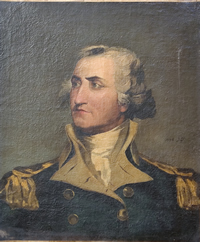 In 1984 the Hawkins
art collection, which had grown to number 158 works,
was examined by a representative of Christie's and a
small number of the attributions in the 1913 catalog
were revised. For example, this portrait of
George Washington attributed in the catalog to John
Trumbull is now thought to be a forgery. (See
the notes to record #49 for an interesting commentary.)
Hawkins lamented the obstacles in the way of a
collector "not of the millionaire class"
and expressed the philosophy that "a real work
of art does not depend upon a name, may have been
painted by an obscure artist, and always with
convincing certainty stands and speaks for itself."
In 1984 the Hawkins
art collection, which had grown to number 158 works,
was examined by a representative of Christie's and a
small number of the attributions in the 1913 catalog
were revised. For example, this portrait of
George Washington attributed in the catalog to John
Trumbull is now thought to be a forgery. (See
the notes to record #49 for an interesting commentary.)
Hawkins lamented the obstacles in the way of a
collector "not of the millionaire class"
and expressed the philosophy that "a real work
of art does not depend upon a name, may have been
painted by an obscure artist, and always with
convincing certainty stands and speaks for itself."
The
Annmary Brown Memorial is open to the public Monday
through Friday from 1:00 to 5:00 pm with some
exceptions. It is advisable to call in advance:
401-863-1994. For further information about
visiting the Memorial contact FOL@brown.edu.
